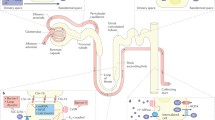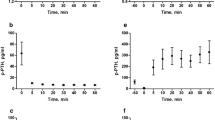Abstract
Extracellular ionized calcium (Ca2+) is the primary physiological regulator of parathyroid hormone (PTH) secretion and the G protein-coupled receptor (CaR) that mediates this response has been cloned from bovine and human parathyroid glands. The Ca2+ set-point for the regulation of PTH secretion is right-shifted in primary hyperparathyroidism (1°HPT), but whether there is a similar shift in 2°HPT is unclear. Additionally, the molecular defects associated with such changes in the set-point remain uncharacterized. These experiments were designed to determine (1) if changes in set-point occur in rats with 2°HPT induced by chronic renal insufficiency (CRI) or dietary Ca deficiency, and (2) whether any changes in set-point are mirrored by changes in steady-state mRNA levels for the parathyroid CaR. CaR mRNA levels were quantified in pairs of glands from individual rats using a solution hybridization assay. Blood urea nitrogen and PTH levels were ∼ 4-fold higher in rats with CRI induced by 5/6 nephrectomy 7 weeks earlier. Rats with CRI were also significantly hypocalcemic and hyperphosphatemic. The setpoint was unchanged in CRI rats and CaR mRNA levels were also unaffected. Normal rats fed a 0.02% Ca diet for 6 weeks were markedly hypocalcemic, and had 10- and 15-fold increases in plasma PTH and 1,25-dihydroxyvitamin D3 levels, respectively. Technical problems prevented assessment of the set-point in these animals, but parathyroid gland CaR mRNA levels were identical in both dietary groups. Thus, neither alterations in mRNA levels for the CaR nor changes in the set-point play demonstrable roles in the pathogenesis of 2°HPT in these models.
Similar content being viewed by others
References
Brown, E.M. (1983). Four parameter model of the sigmoidal relationship between PTH release and extracellular calcium concentration in normal and abnormal parathyroid tissue.J. Clin. Endocrinol. Metab.,56, 572–581.
Brown, E.M. (1991). Extracellular Ca2+ sensing, regulation of parathyroid cell function, and the role of Ca2+ and other ions as extracellular (first) messengers.Physiol. Rev.,71, 371–411.
Brown, E.M., Gardner, D.G., Brennan, M.F., Marx, S.J., Spiegel, A.M., Attie, M.F., Downs, R.W., Jr., Doppman, J.L. & Aurbach, G.D. (1979). Calcium-regulated parathyroid hormone release in primary hyperparathyroidism. Studies in vitro with dispersed parathyroid cells.Am. J. Med.,66, 923–931.
Brown, E.M., Wilson, R.E., Eastman, R.C., Pallotta, J. & Marynick, S.P. (1982). Abnormal regulation of parathyroid hormone release by calcium in secondary hyperparathyroidism due to chronic renal failure.J. Clin. Endocrinol. Metab.,54, 172–179.
Brown, E.M., Gamba, G., Riccardi, D., Lombardi, M., Butters, R., Kifor, O., Sun, A., Hediger, M.A., Lytton, J. & Hebert, S.C. (1993). Cloning and characterization of an extracellular Ca2+ sensing receptor from bovine parathyroid.Nature,366, 575–580.
Capuano, I.V., Krapcho, K.J., Hung, B.C., Brown, E.M., Hebert, S.C. & Garrett, J.E. (1994). Characterization of the human calcium receptor gene.J. Bone Miner. Res.,9, S145 (Abstract).
Chen, P.S., Jr., Toribara, T.Y. & Warner, H. (1956). Microdetermination of phosphorus.Anal! Chem.,28, 1756–1758.
Cloutier, M., Gascon-Barré, M. & D'Amour, P. (1992). Chronic adaptation of dog parathyroid function to a low-calcium-high-sodium-vitamin D-deficient diet.J. Bone Miner. Res.,7, 1021–1028.
D'Amour, P., Weisnagel, J., Rousseau, L., Brossard, J.H., Ste.-Marie, L.-G. & Lepage, R. (1994). The parathyroid functionin vivo in primary hyperparathyroidism. Comparison with normals.J. Bone Miner. Res.,9, S337 (Abstract).
Findlay, D.M. & Martin, T.J. (1984). Relationship between internalization and calcitonin-induced receptor loss in T 47D cells.Endocrinology,115, 78–83.
Fox, J. (1990). Production and metabolicclerance rates of 1,25-dihydroxyvitamin D3 during maturation in rats: studies using a primed-infusion technique.Horm. Metab. Res.,22, 278–282.
Fox, J. (1991). Regulation of parathyroid hormone secretion by plasma calcium in aging rats.Am. J. Physiol.,260, E220-E225.
Fukada, N., Tanaka, H., Tominaga, Y., Fukagawa, M., Kurokawa, K. & Seino, Y. (1993). Decreased 1,25-dihydroxyvitamin D3 receptor density is associated with a more severe form of parathyroid hyperplasia in chronic uremic patients.J. Clin. Invest.,92, 1436–1443.
Fukagawa, M., Kaname, S., Igarishi, T., Ogata, E. & Kurokawa, K. (1991). Regulation of parathyroid hormone synthesis in chronic renal failure in rats.Kidney Int.,39, 874–881.
Galper, J.B., Dziekan, L.C., Miura, D.S. & Smith, T.W. (1982). Agonist-induced changes in the modulation of K+ permeability and beating rate by muscarinic agonists in cultured heart cells.J. Gen. Physiol.,80, 231–256.
Garrett, J.E., Capuano, I.V., Hammerland, L.G., Hung, B.C.P., Brown, E.M., Hebert, S.C., Nemeth, E.F. & Fuller, F. (1995). Molecular cloning and functional expression of human parathyroid calcium receptor cDNAs.J. Biol. Chem.,270, 12919–12925.
Goodman, W.G., Belin, T., Ramirez, J.A., Gales, B., Segre, G.V., Jüppner, H. & Salusky, I.B. (1994). A comparison of calcium-regulated PTH release in mild and severe secondary hyperparathyroidism.J. Am. Soc. Nephrol.,5, 880 (Abstract).
Heath, H., III. (1994). Familial benign hypercalcemia-from clinical description to molecular genetics.West. J. Med.,160, 554–561.
Heath, H., III., Odelberg, S., Brown, D., Hill, V.M., Robertson, M., Jackson, C.E., Teh, B.T., Hayward, N., Larsson, C., Buist, N., Garrett, J. & Leppert, M. (1994). Sequence analysis of the parathyroid cell calcium receptor (CaR) in familial benign hypercalcemia (FBH): a multiplicity of mutations?J. Bone Miner. Res.,9, S414 (Abstract).
Khosla, S., Ebeling, P.R., Firek, A.F., Burritt, M.F., Kao, P.C. & Heath, H., III. (1993). Calcium infusion suggests a set-point abnormality of parathyroid gland function in familial benign hypercalcemia and more complex disturbances in primary hyperparathyroidismJ. Clin. Endocrinol. Metab.,76, 715–720.
Labarca, C. & Paigen, K. (1980). A simple, rapid, and sensitive DNA assay procedure.Anal. Biochem.,102, 344–352.
LeBoff, M.S., Shoback, D., Brown, E.M., Thatcher, J., Leombruno, R., Beaudoin, D., Henry, M., Wilson, R., Pallotta, J., Marynick, J., Stock, G. & Leight, G. (1985). Regulation of parathyroid hormone release and cytosolic calcium by extracellular calcium in dispersed and cultured bovine and pathological human parathyroid cells.J. Clin. Invest.,75, 49–57.
Ledger, G.A., Burritt, M.F., Kao, P.C., O'Fallon, W.M., Riggs, B.L. & Khosla, S. (1994). Abnormalities of parathyroid hormone secretion in elderly women that are reversible by short term therapy with 1,25-dihydroxyvitamin D3.J. Clin. Endocrinol. Metab.,79, 211–216.
Marx, S.J., Fraser, D. & Rapoport, A. (1985). Familial hypocalciuric hypercalcemia: mild expression of the gene in heterozygotes and severe expression in homozygotes.Am. J. Med.,62, 698–706.
Mayer, G.P. & Hurst, J.G. (1978). Sigmoidal relationship between parathyroid hormone secretion rate and plasma calcium concentration in calves.Endocrinology,102, 1036–1042.
Mithal, A., Kifor, O., Kifor, I., Yassilev, P., Butters, R., Krapcho, K., Simin, R., Fuller, F., Hebert, S.C. & Brown, E.M. (1995). The reduced responsiveness of cultured parathyroid cells to extracellular Ca2+ is associated with marked reduction in the expression of extracellular Ca2+ sensing receptor messenger ribonucleic acid and protein.Endocrinology,136, 3087–3092.
Okazaki, T., Igarashi, T. & Kronenberg, H.M. (1988). 5′-Flanking region of the parathyroid hormone gene mediates negative regulation by 1,25-(OH)2 vitamin D3.J. Biol. Chem.,263, 2203–2208.
Pearce, S.H.S., Trump, D., Wooding, C., Besser, G.M., Chew, S.L., Heath, D.A., Hughes, I.A. & Thakker, R.V. (1994). Four novel mutations in the calcium-sensing receptor gene associated with familial benign (hypocalciuric) hypercalcaemia.J. Bone Miner. Res.,9, S145 (Abstract).
Pollak, M.R., Brown, E.M., Chou, Y.-H.W., Hebert, S.C., Marx, S.J., Steinmann, B., Levi, T., Seidman, C.E. & Seidman, J.G. (1993). Mutations in the human Ca2+ sensing receptor gene cause familial hypocalciuric hypercalcemia and neonatal severe hyperparathyroidism.Cell,75, 1297–1303.
Ramirez, J.A., Goodman, W.G., Gornbein, J., Menezes, C., Moulton, L., Segre, G.V. & Salusky, I.B. (1993). Directin vivo comparison of calcium-regulated parathyroid hormone secretion in normal volunteers and patients with secondary hyperparathyroidism.J. Clin. Endocrinol. Metab.,76, 1489–1494.
Riccardi, D., Park, J., Lee, W.-S., Gamba, G., Brown, E.M. & Hebert, S.C. (1995). Cloning and functional expression of a rat kidney extracellular calcium polyvalent cation-sensing receptor.Proc. Natl. Acad. Sci. USA 92, 131–135.
Rogers, K.V., Dunn, C.K., Conklin, R.L., Hadfield, S., Petty, B.A., Brown, E.M., Hebert, S.C. & Fox, J. (1995). Calcium receptor expression in the parathyroid glands and kidney of vitamin D-deficient rats are not regulated by plasma calcium or 1,25-dihydroxyvitamin D3.Endocrinology,136, 499–504.
Sanchez, C., Goodman, W.G., Ramirez, J.A., Belin, T., Gales, B., Segre, G.V. & Salusky, I.B. (1994). Dynamic assessment of parathyroid function in dialysis patients with either osteitis fibrosa or adynamic renal osteodystrophy.J. Bone Miner. Res.,9, S347 (Abstract).
St. John, A., Thomas, M., Dick, I., Young, P. & Prince, R.L. (1994). Parathyroid function in mild to moderate renal failure: evaluation by oral calcium suppression test.J. Clin. Endocrinol. Metab.,78, 1436–1438.
Teitelbaum, A.P., Silve, C.M., Nyiredy, K.O. & Arnaud, C.D. (1986). Down-regulation of parathyroid hormone (PTH) receptors in cultured bone cells is associated with agonist-specific intracellular processing of PTH-receptor complexes.Endocrinology,118, 595–602.
Udén, P., Halloran, B., Daly, R., Duh, Q.-Y. & Clark, O. (1992). Set-point for parathyroid hormone release increases with postmaturational aging in the rat.Endocrinology,131, 2251–2256.
Zhong, M., Finch, J., McCracken, R., Morrissey, J., Slatopolsky, E. & Brown, A.J. (1994). Rat parathyroid gland calcium receptor: regulation by 1,25-dihydroxyvitamin D3 but not by dietary hyperparathyroidism.J. Bone Miner. Res.,9, S217 (Abstract).
Author information
Authors and Affiliations
Rights and permissions
About this article
Cite this article
Rogers, K.V., Conklin, R.L., Lowe, S.H. et al. Parathyroid gland calcium receptor mRNA levels are unaffected by chronic renal insufficiency or low dietary calcium in rats. Endocr 3, 769–774 (1995). https://doi.org/10.1007/BF02935679
Received:
Accepted:
Issue Date:
DOI: https://doi.org/10.1007/BF02935679




